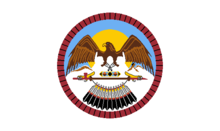
Back شعب يوت Arabic یوتلر AZB Юты (індзейцы) Byelorussian Юта (племе) Bulgarian Tribu Ute Catalan Juteové Czech Ute (Volk) German Ute Spanish مردم یوت Persian Ute-intiaanit Finnish
 | |
 Chief Severo and family, c. 1899 | |
| Total population | |
|---|---|
| 4,800[1]–10,000[2] | |
| Regions with significant populations | |
| Languages | |
| English, Spanish, Ute (Núuchi-u)[1] | |
| Religion | |
| Native American Church, traditional tribal religion, and Christianity | |
| Related ethnic groups | |
| Southern Paiutes,[1] Chemehuevis, Kawaiisu |
Ute (/ˈjuːt/) are the indigenous, or Native American people, of the Ute tribe and culture among the Indigenous peoples of the Great Basin. They had lived in sovereignty in the regions of present-day Utah and Colorado.
In addition to their ancestral lands within Colorado and Utah, their historic hunting grounds extended into current-day Wyoming, Oklahoma, Arizona, and New Mexico. The tribe also had sacred grounds outside their home domain that were visited seasonally.
There were 11 historic bands of Utes. Although they generally operated in family groups for hunting and gathering, the communities came together for ceremonies and trading. Many Ute bands were culturally influenced by neighboring Native American tribes and Puebloans, with whom they traded regularly.
After contact with early European colonists, such as the Spanish, the Ute formed trading relationships. The theft and the acquisition of horses from the Spanish changed their lifestyle dramatically, affecting mobility, hunting practices, and tribal organization. Once primarily defensive warriors, they became more like the Europeans as adept horsemen who used horses to raid other tribes. Certain prestige within the community was based upon a man's horsemanship (tested during horse races), as well as the number of horses a man owned.
As the American West began to be settled by white European gold prospectors and colonialists in the mid-1800s, the Utes were increasingly pressured or killed and then eventually forced off their ancestral lands. They entered into treaties with the United States government to preserve their lives and some of their land, but were eventually relocated to the government-created reservations. A few of the key tribal land defensive conflicts during this period include the Walker War when the religious sect of Mormons arrived (1853), the Black Hawk War where other Native Americans went for treaty but were slaughtered by US forces (1865–72), and the Meeker Massacre in which the Utes tried to regain control of their lands with warring tactics (1879).
Very few Ute people are left, and they now primarily live in Utah and Colorado, within three Ute tribal reservations: Uintah-Ouray in northeastern Utah (3,500 members); Southern Ute in Colorado (1,500 members); and Ute Mountain which primarily lies in Colorado, but extends to Utah and New Mexico (2,000 members). The majority of Ute live on these reservations with limited resources compared to their original lands, although some reside off-reservation.
- ^ a b c d "Ute-Southern Paiute". Ethnologue. Retrieved 27 Feb 2014.
- ^ "American Indian, Alaska Native Tables from the Statistical Abstract of the United States: 2004–2005" (Archived 2012-10-04 at the Wayback Machine). US Census Bureau, USA.
© MMXXIII Rich X Search. We shall prevail. All rights reserved. Rich X Search